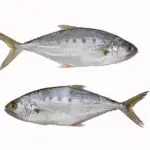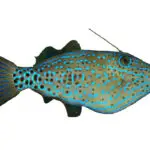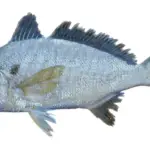As far as saltwater gamefish go, cobia checks all of the boxes. They are aggressive feeders, relentless fighters, and phenomenal table fare.
Regardless of their aggressive nature, are cobia good to eat? Let’s get into it!
This post may contain affiliate links. As an Amazon Associate, I earn from qualifying purchases
Table of Contents
- Can You Eat Cobia?
- What Does Cobia Taste Like?
- Can You Eat Cobia Raw?
- Is Cobia a Healthy Fish to Eat?
- How To Prepare Cobia to Eat
- What is the Best Way to Cook Cobia?
- Blackened Cobia Recipe
- Is Cobia Sustainable?
- FAQ’s
- Conclusion
Can You Eat Cobia?
Cobia is a highly desired fish that is popular with anglers and seafood lovers. Their mild flavor and muscle thickness make them one of the more versatile fish to cook. Cobia is fantastic to eat when raw, fried, grilled, broiled, sauteed, blackened, and smoked.
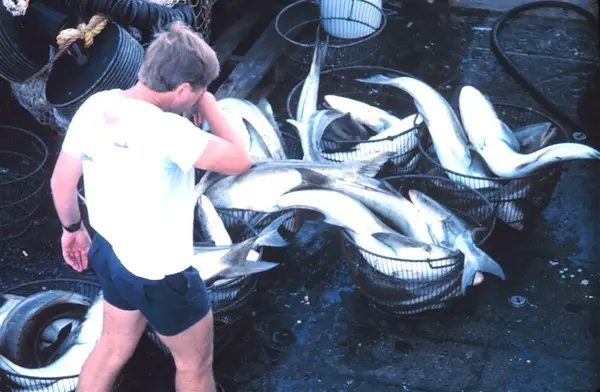
Cobia might be one of the best-tasting fish you’ve probably never heard of. It is a very popular target for anglers along the Gulf Coast and East Coast, but cobia might be a new name for you outside of those areas.
Due to their migratory and solitary nature, commercial fishing for cobia is limited. You will be hard-pressed to find cobia on a menu in states that don’t fall in their migration path.
If you see cobia on a menu or in a seafood market give it a shot and let your taste buds dance.
What Does Cobia Taste Like?
The taste is very clean and mild, not fishy. Thanks to the cobia’s balanced fat content, a bite of cobia will fill your taste buds with a buttery, sweet, and slightly citrus-like flavor.
When first sinking your teeth into a cobia filet, you may notice a familiar flakiness that is like most whitefish. You may also be surprised by the firm and dense texture of the filets.
Cobia is not an oily fish by any means. Thanks to the thickness of the filets and fat content present, cobia filets are perfect for almost any cooking method.
When eaten raw, you will notice a clean and slightly buttery flavor. When cooked, that naturally buttery flavor gets even better.
Due to the versatility of cooking methods that can be applied and the clean flavor, cobia is an excellent fish to prepare for first-time fish eaters. That dreaded “fishy” flavor is hard to accidentally create with cobia.
Cobia is generally like a combination of several fish. If a red drum, flounder, halibut, grouper, and wahoo mated, the result would be a bite of a cobia filet.
It is similar to a red drum or flounder’s mild flavor and flakey texture.
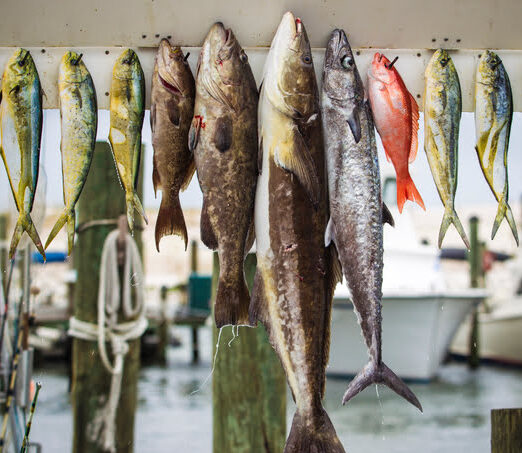
Do You Love Seafood?
Can You Eat Cobia Raw?
Cobia’s excellent flavor, mild fat content, and density make it a great choice to eat raw. The thickness of the filets allows for thinly sliced sashimi or an excellent addition to sushi.
If sashimi is not your thing, cobia makes great ceviche. Add it to a bowl of citrus and acidic flavors to let it break the filet down a bit. Mix in some tomato, jalapeno, onion, and bell peppers and you enjoy it with chips.
As with most fish, it is important to take proper care of the fish to prevent any bacterial contamination. Get it on ice immediately.
Is Cobia a Healthy Fish to Eat?
While most fish are generally healthy, whitefish meat, such as Cobia, is especially good for you to eat. Cobia meat is low-calorie and packed with protein, vitamin D, and selenium.
Not to mention, it is full of heart-healthy omega-3 fatty acids. Vitamin D and omega-3 fatty acids are beneficial for the brain and heart.
The versatility of cobia in the kitchen makes it an awesome fish to pair with all of those clean-eating diets out there.
You can keep it simple by pan-searing it in olive oil with some salt and pepper and throwing it on a salad for a nice healthy meal. Cobia also pairs well with root vegetables, peppers, and broccoli.
One of my favorite protein-packed cobia meals is to season it with salt, pepper, and garlic powder. After cooking, you can squeeze fresh lemon onto the filets.
How To Prepare Cobia to Eat
When caught on rod and reel, which I highly recommend, it is extremely important to get cobia on ice fast. Large, powerful fish like cobia need to be cooled down quickly to prevent the meat from spoiling.
Luckily, most fish meat has indicators of when it is bad, such as smell, sight, or even taste. Keep an eye on those indicators to ensure your Cobia is still good to eat!
Cobia will absolutely freak out when brought aboard. They have very sharp spines running along the top of their body just in front of the dorsal fin, so be mindful of those!
After they calm down, it is essential to bleed them out by cutting their gills. This helps prevent that fishy taste we all hate.
Before throwing the fish in the cooler, it is best to create an ice slurry. You do this by adding some saltwater to your cooler, enough to make the ice float.
The mixture of the ice and saltwater creates a super cold bath for your cobia that will keep it nice and fresh. Put the fish head first into the slurry, make sure it is submerged.
Fileting a large fish like a cobia requires patience and a sharp knife. Cobia yields an incredible amount of meat, and it’s important not to let it go to waste.
Cobia cheek, rib meat, and collars are all delicious, even though they are often discarded.
If you are purchasing cobia from a seafood market, make sure you keep the filets nice and cool until you are ready to cook.
Most seafood markets do a good job of preparing the filets, but they tend to leave the bloodlines and red meat. The bloodlines and red meat create that foul fishy taste. You can use a sharp knife to remove those pieces.
What is the Best Way to Cook Cobia?
Cobia is like a “choose your own ending” fiction book. Due to the flavor and thickness of cobia filets, they can be cooked in various ways.
As with most seafood, it’s best not to overcomplicate the cooking process and flood the fish with ingredients. Keep it simple. Don’t overcook it!
Even though it is difficult to overcook cobia it can happen. Cobia should be cooked to an internal temperature of 155 degrees Fahrenheit.
For those who prefer visual cooking cues, Cobia is usually done cooking when the filet turns white and flakes.
Cobia does well with cajun-style seasonings like Old Bay or Seafood Magic. Those seasonings paired with a spritz of lemon juice pan seared, grilled, or roasted in the oven are tough to beat.
The density of cobia works well with sauces and marinades like your favorite barbecue sauce or Italian dressing.
The fish also does well with some heat. Season it with chili powder and lime to make it pop a bit.
Cobia also pairs well with bell peppers, onions, tomatoes, broccoli, root vegetables, and beans. You could substitute cobia into any of your favorite poultry dishes.
Blackened Cobia Recipe
Blackening cobia is one of the most popular ways to prepare this fish. It is a simple way to celebrate the natural flavors of the fish while adding some spice and crispiness to it.
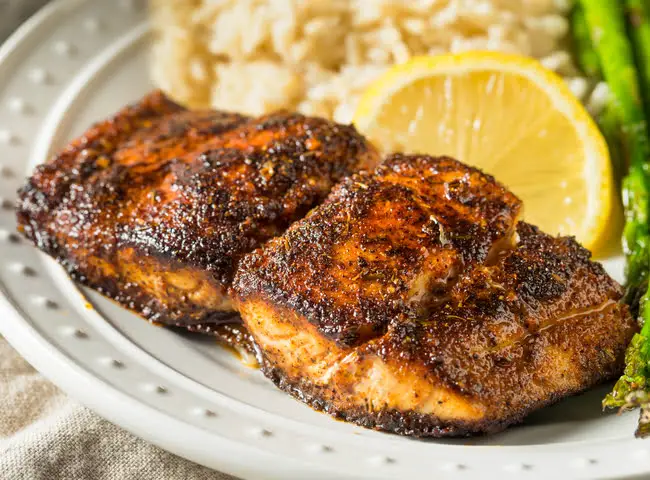
When I prepare cobia this way, you should cube the filets into bite-sized nuggets. This is a great way to use the fish for multiple applications like tacos, rice dishes, or even salads.
Ingredients
- 1-2 Cobia Filets, Cubed
- ¼ Cup of Cajun Seasoning
- ½ Stick of Butter
- 1 Cup of Flour
- Half of a Lemon
- 1 Tablespoon of Vegetable Oil (or your favorite high smoke point oil)
Instructions
- After the filets are cubed, pour the cajun seasoning into a bowl and the cup of flour onto a plate.
- Lightly coat each cube in the cajun seasoning and then roll in the flour. Set aside.
- After all of the cobia cubes are seasoned and coated with flour, melt the butter and heat the vegetable oil in a cast iron skillet on medium-high heat.
- When the butter has browned and you feel the heat coming off the pan, place the cobia cubes into the pan evenly spaced. The cubes should sizzle when they hit the pan.
- Let each side cook for 1-2 minutes, depending on the thickness of the cubes.
- Squeeze lemon over the cubes each time that you flip them.
- The cobia is done when it has a crispy, golden brown color.
Is Cobia Sustainable?
By commercial standards, cobia is a sustainable species. They often are not targeted by commercial fishermen and are only caught as bycatch.
That being said, cobia are considered excellent candidates for aquaculture. They are currently being raised in offshore farms worldwide for commercial use.
Their excellent meat and fast growth rate have them in the front of the line for aquaculture production.
Recreation anglers are responsible for an overwhelming bulk of the cobia harvest yearly. Because of that, fisheries are heavily regulated but in good stock.
FAQ’s
Does Cobia Taste Fishy?
Cobia’s natural, clean, buttery flavor precedes it. It has just the right amount of oil and fat to avoid that undesired fishy taste.
Like all fish, it is important to take proper care of the filets to prevent spoiling.
Is Cobia Expensive?
It all depends. It may be expensive if you purchase cobia in a place where they don’t naturally live.
Typically, you can expect to pay between $22-$24/pound for Cobia.
Is Cobia High in Mercury?
It is always important to keep in mind the mercury content of any large saltwater fish. Cobia is no different.
Reports are always changing, but Cobia has previously ranked among the highest in mercury content. It is best to practice moderation with any pelagic creature.
Conclusion
Fresh cobia is hard to beat, and if you’ve caught it yourself, you’ve definitely earned it. There is a reason why this fish is so revered amongst anglers and seafood lovers…they’re delicious to eat and versatile enough for nearly any recipe.

Growing up in Florida, I’ve been surrounded by saltwater my entire life…and I love sharing my passion with others.
To learn more about why I started Saltwater Mecca, visit the ABOUT page.
Thank you for reading this article. Browse around & have some fun!

